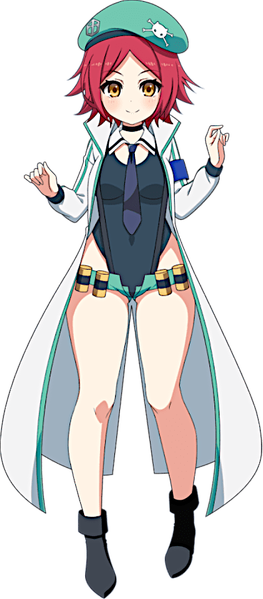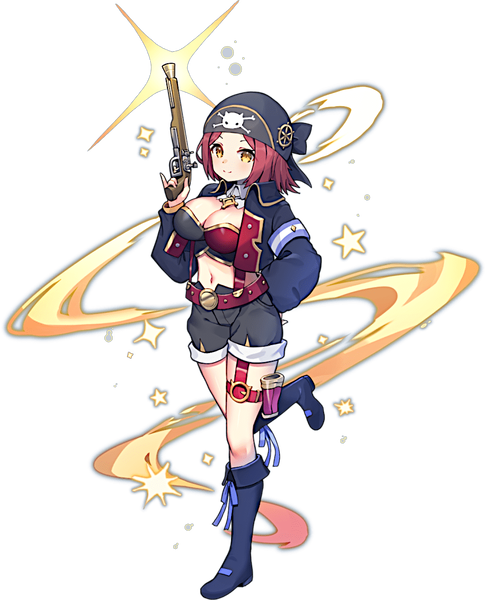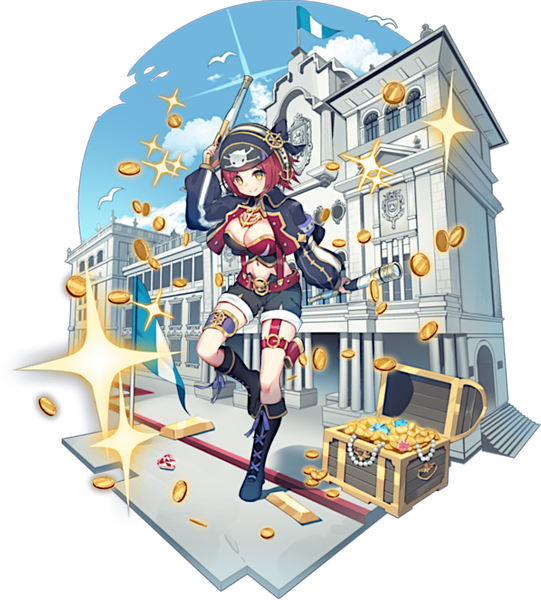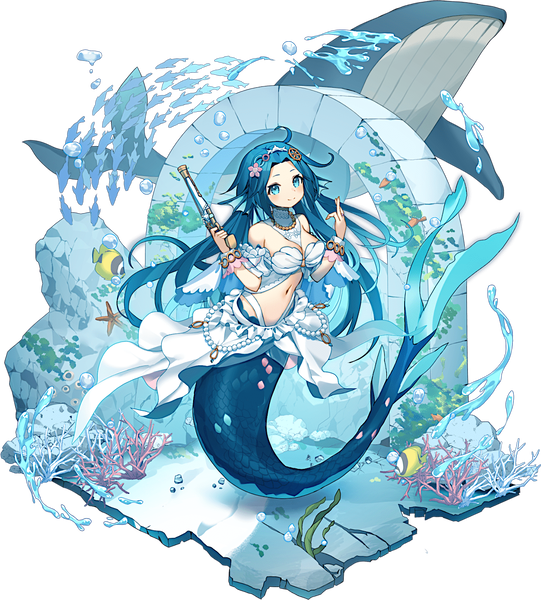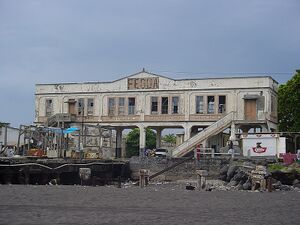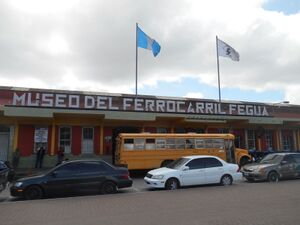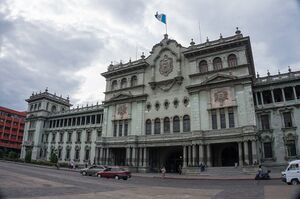Guatemala
| Guatemala | |||||
|---|---|---|---|---|---|
| Japanese Name | グアテマラ | ||||
| Weapon | |||||
| Race | Human | ||||
| Nationality | |||||
| Birthday | April 19 | ||||
| Constellation | Aries | ||||
| Talents | Versatile in water | ||||
| Likes | Love, Jade, Quetzal, Pretty or sparkly things | ||||
| Dislikes | Water, Disaster, Fate | ||||
| Strengths | Able to live in the moment as hard and as fast as she can no matter what | ||||
| Weaknesses | Looks too far into the past and pretends not to see the future | ||||
| Hobbies | Making her Captain and the pirate ship pretty, Love stories, Astronomical observations, Cooking | ||||
This story's heard of before. Somewhere there survives a supposedly extinct race called 'mermaids', and one of them is saved by a nice man one day when she was about to suffocate. The foolish mermaid wanted to meet him, so she made a contract with a witch and became human.
Layers
Skills
Trivia
- Guatemala's birthday is the 1902 Guatemala earthquake, occurred on April 18 (19th April in Japan) at 8:23 pm with a moment magnitude of 7.5 and a maximum Mercalli intensity of VIII (Severe). The rupture was initiated at a depth of 25 km (16 mi) and the duration was 1 to 2 minutes.
- Her dislike of water and disaster is likely a reference to the incident above, a few weeks before the earthquake there was rain every afternoon for several days straight. Guatemala City was instantly flooded when massive gaps opened in the streets, water pipes ruptured, and huts along with cathedrals disintegrated and collapsed, which also buried hundreds.
- Guatemala's pirate theme is similar to her Captain Port Royal, piracy in the Caribbean began in the 1500s and phased out in the 1830s after the navies of the nations of Western Europe and North America with colonies in the Caribbean began combating pirates.
- Guatemala's mermaid origins may be a reference to Antigua's Central Park in Guatemala, famous for the mermaid fountain Fuente de las Sirenas, where four mermaids on each side of the fountain are spraying streams of water out of their breasts. The fountain was built by Diego de Porres in 1738, who took his inspiration for the fountain from the Neptune Fountain in Bologna, Italy. The fountain predates Hans Christian Andersen's The Little Mermaid in 1836.
- Her weakness in not able to face her future may be a reference to Guatemala's railway system, as of her debut in Mist Train Girls, real life Guatemala is unlikely to have the country's railway system be revived, while the country does have several museums about its past railway history.
- The building in the background of [Forbidden Mermaid's Love] is the National Palace, known as Palacio Nacional de la Cultura (National Palace of Culture) also known colloquially as "Palacio Verde". The flags resemble the national flag of Guatemala.
Counterpart
The Northern Railroad of Guatemala was a railway system that ran from Guatemala City to Puerto Barrios, the main port of Guatemala, between 1896 and 1968. The American United Fruit Company had the monopoly of the railway system through its affiliate, International Railways of Central America, along with the docks at Puerto Barrios, the banana plantations in Izabal and the cargo and passenger transport with its Great White Fleet. The system was highly efficient, but once a parallel highway was built, it could not compete and eventually was handed back to the State of Guatemala in 1968. After that, the system slowly lost its relevance, as the trucks were more profitable than railway transportation along this route. It ceased regular operations in 1996, and has remained partially abandoned since.
In October 1997, a 50-year concession was given to Railroad Development Corporation (RDC) which started to rehabilitate the network. They were delayed by the need to evict squatters who built their cottages on the right-of-way during the previous years and to repair damage caused by thieves and nature. A serious blow was Hurricane Mitch in 1998, which destroyed parts of the line. The first train under RDC management went from Guatemala City to El Chile cement plant on April 15, 1999, and the rest of the line to Puerto Barrios was put into operation in December of that year.
From 1999 until September 2007, Ferrovías Guatemala (FVG), as a subsidiary of RDC, operated 15 engines and 200 railcars on freight trains between Guatemala City and Puerto Barrios. It transported containers, steel, cement, paper and bananas between the Caribbean coast and the capital over a network of 200 miles (320 km) as of 2006, but quit in September 2007. It connected Guatemala City to Puerto Barrios with short branches in Guatemala City container terminal and Puerto Santo Tomás.
Due to the continuing uncertainty leading to losses, FVG decided to suspend all operations as of October 1, 2007 while continuing with legal actions against the Guatemalan government. The arbitration case was finally decided in favor of RDC and US$14·6m paid as compensation. As of 2011, most of the bridges have been dismantled and sold for scrap by thieves, making a potential revival of railways in Guatemala difficult, as it would cost millions of dollars to rebuild.
Palacio Nacional de la Cultura (National Palace of Culture) also known colloquially as "Palacio Verde", is identified as Guatemala City's symbol in its architectural context. It was the most important building in Guatemala and was the headquarters of the President of Guatemala. The building is the origin of all the roads in the Republic and has a spot known as Kilometro Cero (Zero Kilometer). It is presently a museum and is also used for important acts of the government. It is a space dedicated to various artistic activities and temporary exhibitions, as well as housing collections of paintings and sculpture. It was declared a Historic and Artistic Monument on 7 November 1980 and on 11 June 2001 became part of the Ministry of Culture and Sports. It is also known locally as the Green Palace or the Guacamolón, in allusion to the colour of the famous pre-Columbian dish.
In 1932, President General Jorge Ubico published the basis for the design and construction of the palace, and on July 4, 1937, the first stone was placed. The National Palace was built between January 1939 and 1943. On November 10 of that year, the birthday of President Ubico, the present-day Palace was opened. The building is symmetrically designed with a central body, from which there are two lateral bodies, each with three levels and a central courtyard. It is eclectic in style, although the neo-Plateresque style predominates. Its architectural traces are inspired by the Palace of Monterrey in Salamanca and the main façade of the Colegio Mayor de San Ildefonso at the University of Alcalá de Henares, both dating from the first half of the 16th century. The five windows that can be seen on its façade have a significance in that each one of them bears a letter in a border that stands for Jorge Ubico.
The building, constructed of concrete with brick clad in stone turned green, contains murals by the artist Alfredo Gálvez Suárez showing a historical review of the country from colonial times to independence. In total it covers an area of 8,890 m²3 and consists of 350 rooms.1 In the reception hall - located on the second level and one of the most attractive spaces in the building -,1 there is a star-shaped drawing that marks the country's kilometre zero and a two-ton crystal chandelier from which hang four gold-plated quetzal figures (called Rosa nautica).1 In one of the palace's courtyards, the signing of the peace agreement that ended Guatemala's civil war was celebrated. On 4 February 1976, it withstood an earthquake measuring 7.5 on the Richter scale, which destroyed much of the country. Wikipedia
Map
Gallery
- Pages using Tabber parser tag
- Pages using DynamicPageList3 parser tag
- Weapon Gun
- Human
- Flamarine
- Aries
- Element Pierce
- Element Dark
- Element Water
- Metro Train Knights
- Guatemala

